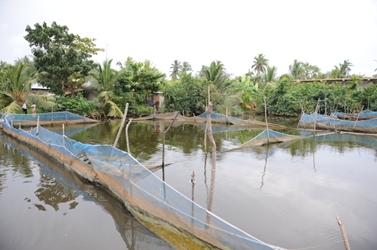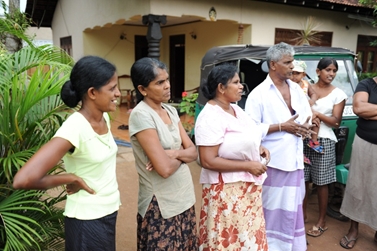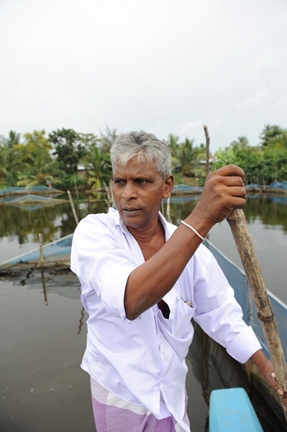Unique ephemeral ponds in a lagoon environment are sources of livelihoods for their communities. But how they impact the lagoon will spell how long they will last.
by Dharshani Weerasekera
Women in Negombo, Sri Lanka are running aquaculture farms as community based organisations (CBOs). The farms are in intertidal ponds near the Dandugam Oya freshwater inlet of the Negombo Lagoon. The collectives not only sell fresh fish to middlemen, they have started microfinancing to support their families. These small scale fish farms are breeding success and empowering women. But they may be adversely affecting a very sensitive environment and the future of their livelihoods.

The farms are in small, ephemeral, brackish water bodies called odai, unique to the area. They border the southern end of the Hamilton Canal, an artificial waterway built along the Muthurajawela wetlands during colonial times. Lagoonal and Kelani River estuarine tides cause regular breaching of the canal banks near the inlet mouth, flooding adjacent depressions.
The resulting shallow ponds became more or less permanent, with their own ecosystems. They are surrounded by mangroves, mangrove associates and other plants, providing unique habitats for certain species of aquatic life and other fauna.
High demand
Fishing in the odai was an old practice before aquaculture became popular. About five years ago, the National Aquaculture Development Authority (NAQDA) started providing aquaculture expertise and regulations. Apart from buying fingerlings, there is little capital cost. State subsidies include nets, oru (canoes) and of course, expertise.
Extension officers update skills and environmental awareness annually. Milkfish and tilapia are reared and fed on bought feed in pens until big enough for the open ponds. Village communities are enthusiastic and prospering. The high demand for milk fish as bait for offshore fisheries drives a profitable market. The major new fisheries harbour at Dikkowita nearby will likely increase it.
Benefits clear for communities, but what about the lagoon?

As livelihoods go, fish farmers have it relatively easy. They are not dependent on energy sources, groundwater extraction or fertilisers, and labour is minimal. For families, fresh fish provides nutritious meals. However, although these activities support pro-poor, pro-women livelihoods, they may be unsustainable.
As an economic unit, Negombo Lagoon is probably the most active and productive fisheries centre in the island. Local communities have been stepping in, stepping up and cashing in. Rohini Rodrigo is the president of an association of odai community fish farms near Negombo lagoon. “The association is doing well. We have 50 members farming several varieties of fish. Milkfish take four months to grow before harvesting and it is very profitable,” she said.
With whole communities becoming stakeholders in lagoon resources in this way, how are their perpetual aquaculture activities impacting the lagoon? A comprehensive study by IWMI on Sri Lankan lagoons highlights the fact that what is being put into the lagoon can have just as serious an impact as what is taken out. Fish effluent from nurseries discharged into odai, is flushed by tides into the lagoon and can affect the aquatic ecosystem.
Lead author of the study, Professor Ivan Silva, says the lagoon can regulate the effects of odai fish farming to an extent because of their relative sizes. However, he adds that, “Farming of milk fish in odai is intensive and systems of this nature should not be crowded because the natural resources are limited.” The environmental impact of exotic fish species such as tilapia is another important factor to monitor.
The study reveals just how vulnerable and sensitive lagoon environments are to human interventions. It strongly recommends environmental impact studies should precede any economic development. The odai fish farms cannot be excluded for being small scale as they are constant, year-round activities. Their success may encourage other communities to establish similar farms.
Building resilience in the community
Silva suggests “It would be wise for these communities to develop other income sources to reduce pressure on the lagoon environment.” This, along with microfinancing, can help build economic resilience into communities. Value addition to farmed fish, such as drying and smoking can increase income from the same catch. Breeding their own fingerlings can reduce overheads.

The rapid expansion of shrimp aquaculture during the last decade provides valuable lessons. The FAO reported1 environmental problems, including damaging effects to ecologically sensitive habitats, wildlife and wild fish populations due to shrimp farming. It also destroyed over 1,200 ha1 of mangroves.
The odai are economically important for these small scale producers but have received little or no study. How can the CBOs ensure that the success of their livelihoods will last as long as their farms?
Any answer must surely include participatory management using more sustainable practices and monitoring of environmental impact. Capacity building for developing alternative livelihoods to dovetail with aquaculture is necessary too. Stepping up the awareness programmes, skills training and microfinancing will be key steps to achieving these. They can then serve as models for other small coastal fish farms.
1FAO National Aquaculture Sector Overview: Sri Lanka 2004-2013 in Fishery and Aquaculture Country profile. Sri Lanka.
Dharshani Weerasekera is an independent writer.

